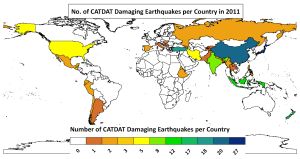Last year, earthquakes and their consequences, such as tsunamis, landslides, and ground settlements, caused a damage of 365 billion US dollars. Hence, 2011 was the year with the so far highest economic losses due to earthquakes. This is the result of an analysis submitted by James Daniell from the Center for Disaster Management and Risk Reduction Technology (CEDIM) of Karlsruhe Institute of Technology (KIT). According to this analysis, 20,500 people died, about a million people lost their homes.
Japan and New Zealand were hit hardest by the catastrophes. “With losses in the amount of 335 billion US dollars alone, the Tohuku earthquake is the most expensive earthquake so far,” says James Daniell. The earthquake with a magnitude of 9 and the following tsunami hit northern Japan on March 11: 19,300 people died, 450,000 lost their homes. The earthquake near Christchurch, New Zealand, in February caused 20 billion dollars of losses. Above all, buildings were destroyed. Large economic losses also resulted from the earthquakes in the Turkish region of Van, in the region of India-Nepal-Tibet, in the Chinese provinces of Yunnan and Xinjiang, and in the U.S. state of Virginia.
Worldwide, at least 133 earthquakes occurred in 2011, during which people died, were injured or lost their homes or which caused immense damage to property. Most often, i.e. 27 times, earthquakes took place in Japan. These were mostly aftershocks of the Tohoku earthquake. China was affected 20 times, Turkey 18 times. Including the aftershock near Christchurch, New Zealand was hit by 17 earthquakes.
20,500 people died as a result of earthquakes, tsunamis, or other consequences. Statistically speaking, this is below the average of the past years. More than 1 million people lost their homes. For comparison: The devastating earthquake on Haiti in 2010 caused about 137,000 casualties, between one and two million people lost their homes. In 2011, the earthquakes and their side effects destroyed or damaged more than 1.7 million buildings, of these, more than one million in Japan alone.
James Daniell published the 43-paged report in cooperation with Armand Vervaeck from the Belgian foundation of SOS Earthquakes. The report is based on the CATDAT database that has been set up systematically by him since 2003. It contains information from online archives, reports of institutions, publications, and from other data collections worldwide. Daniell’s work is financed by the Australian Sir John Monash Foundation.
Complete report in the English language: http://www.cedim.de/download/CATDATDamagingEarthquakesDatabase2011AnnualReview.pdf
In close partnership with society, KIT develops solutions for urgent challenges – from climate change, energy transition and sustainable use of natural resources to artificial intelligence, sovereignty and an aging population. As The University in the Helmholtz Association, KIT unites scientific excellence from insight to application-driven research under one roof – and is thus in a unique position to drive this transformation. As a University of Excellence, KIT offers its more than 10,000 employees and 22,800 students outstanding opportunities to shape a sustainable and resilient future. KIT – Science for Impact.

